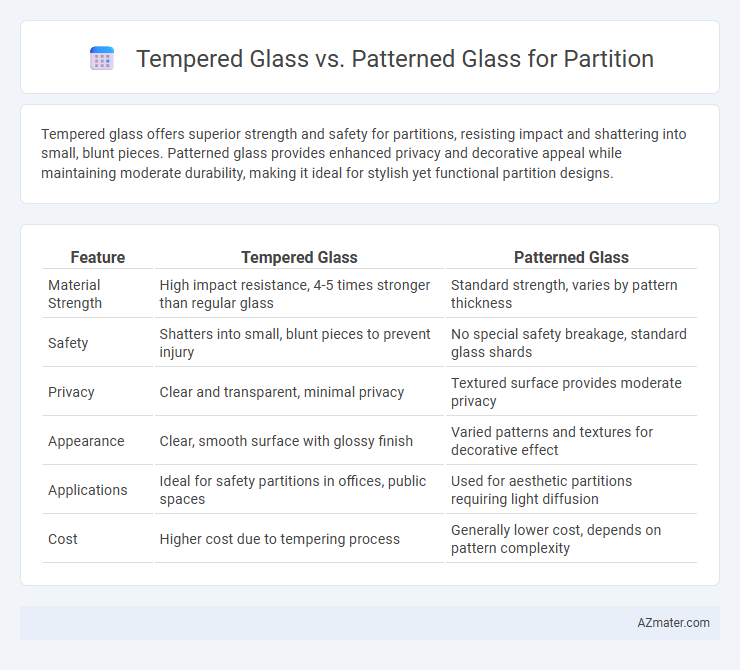Tempered glass offers superior strength and safety for partitions, resisting impact and shattering into small, blunt pieces. Patterned glass provides enhanced privacy and decorative appeal while maintaining moderate durability, making it ideal for stylish yet functional partition designs.
Table of Comparison
| Feature | Tempered Glass | Patterned Glass |
|---|---|---|
| Material Strength | High impact resistance, 4-5 times stronger than regular glass | Standard strength, varies by pattern thickness |
| Safety | Shatters into small, blunt pieces to prevent injury | No special safety breakage, standard glass shards |
| Privacy | Clear and transparent, minimal privacy | Textured surface provides moderate privacy |
| Appearance | Clear, smooth surface with glossy finish | Varied patterns and textures for decorative effect |
| Applications | Ideal for safety partitions in offices, public spaces | Used for aesthetic partitions requiring light diffusion |
| Cost | Higher cost due to tempering process | Generally lower cost, depends on pattern complexity |
Introduction to Glass Partitions
Tempered glass offers superior strength and safety, making it ideal for partitions that require durability and impact resistance. Patterned glass provides enhanced privacy and aesthetic appeal through various textured designs, diffusing light while obscuring visibility. Both options balance functionality and style, with tempered glass prioritizing safety and patterned glass emphasizing visual interest in modern glass partitions.
What is Tempered Glass?
Tempered glass is a type of safety glass processed by controlled thermal or chemical treatments to increase its strength compared to normal glass. It is designed to shatter into small granular chunks instead of sharp shards, reducing injury risk when broken. Commonly used in partitions, tempered glass offers enhanced durability, impact resistance, and safety, making it ideal for high-traffic or high-risk areas.
What is Patterned Glass?
Patterned glass is a type of textured glass featuring embossed designs or patterns that provide privacy while allowing light to pass through, making it ideal for partitions in offices or homes. Unlike tempered glass, which is heat-treated for strength and safety, patterned glass emphasizes decorative aesthetics and visual obscuration. Its varied patterns, such as reed, martini, or pinhead, enhance interior design while maintaining functional separation between spaces.
Aesthetic Differences: Clarity vs. Design
Tempered glass offers superior clarity and a sleek, modern aesthetic ideal for partitions that require maximum light transmission and unobstructed views. Patterned glass provides decorative textures and designs, adding visual interest and privacy while diffusing light softly to create a unique ambiance. Choosing between tempered and patterned glass depends on whether the priority is transparency and minimalism or artistic expression and subtle privacy.
Strength and Safety Comparison
Tempered glass offers superior strength compared to patterned glass, as it undergoes a heat-treatment process that increases its resistance to impact and thermal stress, making it ideal for partitions requiring enhanced durability. Patterned glass, while providing decorative appeal and privacy through textured designs, generally has lower structural strength and is more susceptible to cracking under pressure. In terms of safety, tempered glass shatters into small, blunt pieces that reduce injury risk, whereas patterned glass tends to break into larger, sharper shards, posing a higher hazard in partition applications.
Privacy Levels: Transparency vs. Obscuration
Tempered glass offers high transparency, allowing clear visibility and maximum light transmission, making it ideal for spaces where openness is desired but durability is essential. Patterned glass provides varying degrees of obscuration through textured or frosted designs, significantly enhancing privacy while still permitting light diffusion. Choosing between tempered and patterned glass partitions depends on the required balance between visual privacy and natural light in interior environments.
Maintenance and Cleaning Requirements
Tempered glass partitions offer a smooth, non-porous surface that resists stains and requires minimal maintenance, making it easy to clean with standard glass cleaners and a soft cloth. Patterned glass, while visually appealing with textured designs, can trap dust and dirt in its grooves, demanding more frequent and detailed cleaning to maintain clarity and hygiene. Choosing tempered glass reduces long-term maintenance efforts, whereas patterned glass necessitates specialized cleaning tools to reach intricate patterns effectively.
Cost Analysis: Budget Considerations
Tempered glass generally costs more than patterned glass due to its enhanced safety features and durability, making it a preferred choice for high-traffic areas despite the higher initial investment. Patterned glass offers a more budget-friendly option while providing privacy and decorative appeal, suitable for projects with tighter financial constraints. Comparing long-term value, tempered glass often reduces replacement and maintenance expenses, potentially offsetting its upfront price difference.
Installation Flexibility and Custom Options
Tempered glass offers superior installation flexibility due to its strength and uniform thickness, allowing precise cutting and fitting in various partition designs. Patterned glass provides extensive custom options with textured or decorative finishes, enhancing privacy and aesthetic appeal without compromising functionality. Choosing between tempered and patterned glass depends on whether the priority is structural versatility or distinctive visual customization in partition installations.
Best Applications: Choosing for Your Space
Tempered glass offers superior strength and safety, making it ideal for high-traffic areas and office partitions requiring clear visibility and durability. Patterned glass provides privacy and aesthetic appeal with textured designs, perfect for spaces like conference rooms and bathrooms where light diffusion and discretion are important. Selecting between tempered and patterned glass depends on balancing the need for safety, privacy, and design preferences in your specific environment.

Infographic: Tempered glass vs Patterned glass for Partition
 azmater.com
azmater.com